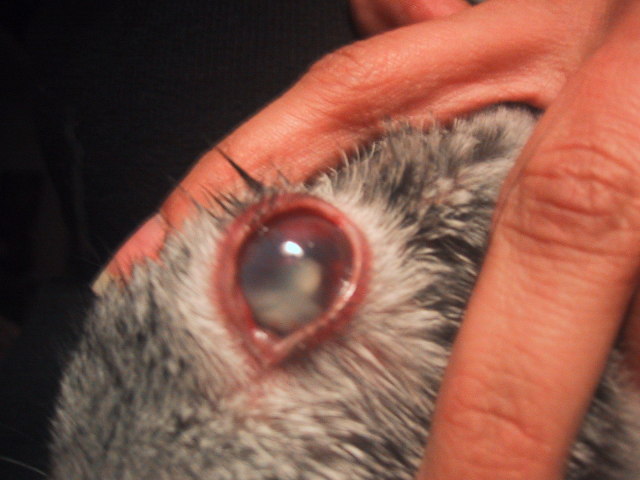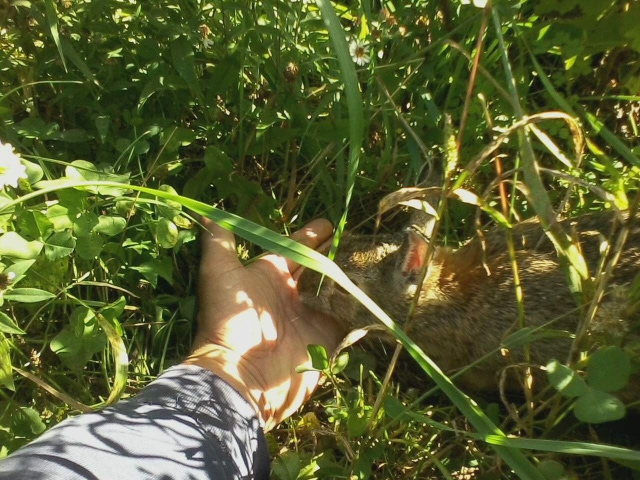QuestionQUESTION: Hi Dana, I came across the All Experts site on a google search today and read your rabbit anesthesia post. I know this is a gray zone area, no simple right and wrong. But my personal experience differs from yours and I wanted to send you this abstract as support - Flecknell, P.A.; Roughan, J.V.; Hedenqvist, P. (1999). Induction of anaesthesia with sevoflurane and isoflurane in the rabbit. Laboratory Animals 33 (1): 41-6, ISSN: 0023-6772.
NAL Call Number: QL55 A1L3
Abstract: The effects of induction of anaesthesia with sevoflurane and isoflurane were studied in rabbits. All rabbits had periods of apnoea (ranging from 30-180 s) during induction which resulted in moderate hypercapnia and acidosis. Arterial pCO2 rose from 4.1 +/- 0.3 kPa to a peak of 7.6 +/- 0.4 kPa (mean +/- SD) (both agents). All animals showed a significant reduction in heart rate (P < 0.05). Heart rate (HR) fell from 226 +/- 33 to a minimum during induction of 57 +/- 32 (sevoflurane) and 199 +/- 41 to 45 +/- 11 (isoflurane). Most animals struggled violently during induction. Use of sevoflurane did not prevent the breath-holding response seen during induction of anaesthesia with other volatile anaesthetics in this species, and the severe apnoea which occurs may represent a significant hazard. The behaviour of the animals indicated that both sevoflurane and isoflurane are aversive, suggesting that this technique should be avoided whenever possible
It's just my opinion, but a polypharmaceutical sedative of reversable drugs given im (midazolam, butorphanol or buprenorphine, medetomindine, etc.)before inhalation anesthesia has been ideal.
Sincerely, Tim Groves DVM
ANSWER: Dear Tim,
That's an interesting study, and I do know that some vets have reported that their rabbit patients struggle briefly when going under iso or sevoflurane. Relatively few have reported idiosyncratic reactions that have resulted in death--but the above makes me wonder if the gas anesthetics might induce enough stress in some individuals to cause arrest.
The abstract doesn't say what the sample size was, but there is one important aspect here: these are laboratory rabbits. These poor bunnies are, by the very nature of their husbandry, usually very stressed and frightened. I am not sure that the reaction of a calm, socialized companion rabbit would be the same as these frightened bunnies whose entire life is one of dread. Rabbits are far more intelligent than the scientific community gives them credit for being. They are highly empathic, and react strongly to signs of stress and fear in each other.
When I've been assisting our vet in surgery and am there to talk to my rabbit pal as s/he's going under, there really isn't any struggle. I think personality and lifestyle may actually make a difference in some cases. I guess I'm not really convinced that the lab rabbits' physiological (and whatever part emotional state might play) reaction to iso and sevo would be exactly the same as that of a calm companion rabbit.
That said, I certainly don't disagree with you that mild sedation or even stronger pre-meds are a good idea before a bunny is gassed down, just to be on the safe side and reduce stress as much as possible.
I was trying to figure out which of my posts on anesthesia you were referring to, and I did go back and find that the first thing that came up on a search was about gassing down a bunny to do a molar float. Some of our vets here do this routinely without pre-anesthetics, but I do agree with you that a pre-anesthetic is probably a better idea, especially if the rabbit has a nervous personality or is easily stressed.
For the past year, at least, if the procedure being done is relatively minor, we've been using diazepam to provide mild sedation (lagomorphs can take a HUGE dose of this stuff and still be alert!) so they don't feel frightened or stressed by the masking. It seems to work very well, especially with our wild sanctuary hares (Black-tailed Jackrabbits) and cottontails.
For more serious procedures (spays and other surgeries), our current vet uses *morphine* as a pre-anesthetic! When we first started going to him, I had serious misgivings about this because of potential respiratory, GI, and thermoregulation problems. But after having more than a dozen rabbits, hares, and cotties undergo procedures with nothing more than morphine on board (sometimes with diazepam we had to give to just get the wild ones into a carrier), I have to say I'm convinced. They seem to suffer so much less pain than with buprenorphine or any other pre-anesthetic we've used before! They come up very quickly at the end of the 8-9 hour "hang time" of the morphine, and appear to feel much better than with some of the other opiates commonly used on rabbits. This same vet also gives a large dose of atropine (despite the atropinase issue!) along with the morphine, which seems to help.
The one pre-anesthetics I've had *really* bad experience with in rabbits has been medetomidine. Even when it's reversed, the rabbits are gorky and miserable for more than 24 hours, and the drug doesn't seem to offer much in the way of analgesia. I actually asked the vet who was using this on rabbit patients to *not* use it on ours, and she switched back to buprenorphine with--in my opinion--much better results. But still not as good as the morphine. Go figure!
Thank you for sharing that abstract. I am very grateful, and think that I will not recommend withholding pre-anesthesia sedation, even for procedures as simple as dental work. Better to be safe than sorry!
Have a great weekend!
Dana
---------- FOLLOW-UP ----------
QUESTION: Dana - thanks so much for sharing your knowledge and time. It's especially important with rabbits (and all lags) since formal literature is limited and/or non-commital, and many colleagues don't have much experience.
Your suggestion about the differnce between laboratory rabbits and "pet" rabbits sounds completely reasonable. And as you note, wherever they come from, if they are "tweaky", sedation is probably a good idea. I have never tried morphine/atropine as a lag premed but would love too. When you have some spare time (smiles...) could you send me the doses?
If i could offer a suggestion - i really dislike diazepam given IM. I only use it IV. It's a pharmacokinetics issue. Midazolam is absorbed better from an IM injection site and the volume need is lower too. It's a benzodiazepine, so the effects are the same.
Thanks again! It's been nice sharing this information with you.
Sincerely, Tim Groves, Western Career College, Stockton, Ca. 209-472-8285
AnswerFOLLOWUP:
Dear Tim,
I got the atropine and morphine dosages from Jim Bogdansky today. So here they are for you, along with his description of use:
"Dana-
I have used morphine in our little lagomorphs for years (> 12 years ) without significant
intra or post op complications. My morphine dosage range is from 2 - 5 mg/kg usually I use 3
mg/kg. I also use atropine at 0.9 mg/kg. The dosing goes back many moons. I initially was
worried about the whole atropine badness but now I'm extremely comfortable.
I'm glad to hear Kyla is doing awesome.
Take care Jim"
Hope that's helpful to you!
Ciao for niao!
Dana
**********
Dear Tim,
Worry not! We give the diazepam orally only. It seems to work very well, though it takes 5mg to get a 2kg jackrabbit relaxed enough to walk into a carrier (still under protest). Do you have any concerns about diazepam administered orally?
I've asked our vet (Dr. Jim Bogdansky) if he would please share his lagomorph dosages for morphine and atropine (I never even asked! Shame on me!), and will send them to you as soon as he responds. He may ask me for your email address to send you the dosages directly, but I'll let you know if that's the case.
Have a great weekend, and thanks for the great information and sharing!
Dana

 Rabbit nest mysteriously lost fur overnight
QuestionQUESTION: My rabbit has two litters; one litter
Rabbit nest mysteriously lost fur overnight
QuestionQUESTION: My rabbit has two litters; one litter
 EXTREMELY concerning eye problem
QuestionTinkerbells Cloudy Ey
QUESTION: Dana,
M
EXTREMELY concerning eye problem
QuestionTinkerbells Cloudy Ey
QUESTION: Dana,
M
 GI Statis ?
Question
COOKIE
Female/age 3yrs/house rabbit/open cage
GI Statis ?
Question
COOKIE
Female/age 3yrs/house rabbit/open cage
 gray ears
QuestionObama
QUESTION: Hi,
I have a lop-eared r
gray ears
QuestionObama
QUESTION: Hi,
I have a lop-eared r
 Rabbit treats
QuestionFeeding Lilly
Petting Lilly
QUE
Rabbit treats
QuestionFeeding Lilly
Petting Lilly
QUE